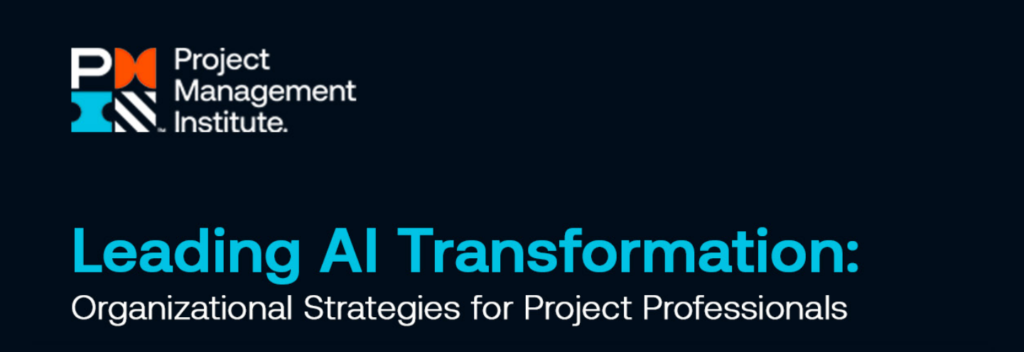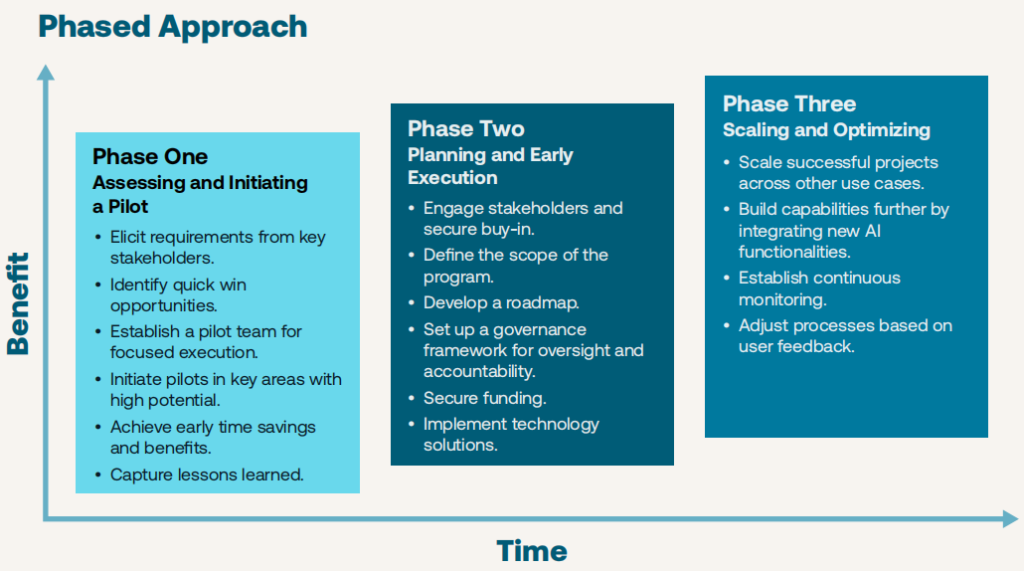
Here is a Summary of a new Guide coming from the Project Management Institute that is helping us as AI Technical Project Managers lead the transformation of organizations using AI.
Overview
This guide offers a strategic roadmap for integrating artificial intelligence (AI) into organizational operations, with a focus on the roles of the Project Management Office (PMO), project professionals, and Transformation Management Office (TMO). It provides practical strategies to drive AI adoption, manage change, and achieve measurable business value.
The Benefits of AI Adoption
- Enhanced decision-making – AI driven analytics can provide predictive insights that improve strategic decisions across organizations
- Increased efficiency and productivity – AI automates repetitive tasks such as data processing, reporting and project scheduling
- Enhanced customer experience – AI technologies like chatbots and personalized marketing enable companies to provide timely and relevant services
- Scalability – AI systems handle large-scale tasks more efficiently than manual processes. As companies grow, AI enables them to scale operations by automating tasks and providing analytics that facilitate expansion without requiring proportional increases in the workforce
- Improved risk management – AI powered risk management tools analyze past project performance data to predict potential risks, helping the organization mitigate issues before they arise
- Agility and innovation – AI helps organizations stay ahead by providing real-time insights into market changes, allowing them to react faster to evolving business environments
- Cost reduction – AI reduces costs by automating labor-intensive tasks, optimizing resource use and ensuring smoother workflows
- Talent augmentation – AI does not replace human talent but complements it. By handling tedious or time-consuming tasks, AI enables employees to focus on creative, strategic work. This augmentation of human capabilities is especially valuable for knowledge workers in industries like project management
- Better project outcomes – AI’s abilities to provide accurate forecasts, optimize resource planning and monitor performance contribute to better project outcomes
- Competitive advantage – Organizations that adopt AI early position themselves as industry leaders driving innovation and efficiency. AI adoption is increasingly seen as a critical factor for companies seeking a sustainable competitive advantage
Understanding the AI Adoption Life Cycle

Exploration and Strategy (Initiation)
- support leadership in defining the business case for AI
- conduct initial feasibility studies, market research and risk assessment
- identify key stakeholders
- evaluate the availability and quality of data
- need for specialized AI talent
- develop mitigation strategies for AI specific risks:
- data bias
- model accuracy
- regulatory compliance
- Consider:
- ethical considerations
- integration of ML models into existing systems
- impact of AI models on business models and operations
Planning and Design (Planning)
- ensure clear goals, timelines, budgets and success metrics
- define scope
- design project charters
- resource allocation
- create AI adoption roadmaps
- plan integration of data pipelines
- development of AI models
- continuous monitoring and refinement of these models
Pilot and Implementation (Execution)
- monitor AI project execution against predefined goals
- track progress
- manage resources
- ensure AI projects are delivered on time and within scope
- ensure AI project is continuously evaluated for it’s impact on data quality and model performance
- ensure project plans include strategies for:
- data validation
- model tuning
- integration of AI into existing systems
Evaluation and Optimization (Monitoring and Controlling)
- conduct post-implementation reviews that specifically assess the AI model’s accuracy, reliability and ethical implications of AI models
- gather feedback from users to understand the real-world impact of AI and monitor the return of investment (ROI) using AI analytics to predict future performance and identify areas for optimization
- adjust plans and strategies based on these insights to ensure continuous improvement
Scaling and Institutionalization (Closure)
- manage documentation, knowledge transfer and lessons learned
Data-Related Challenges

Data Quality
- establishing standards, metrics and reporting processes
- check data is clean, accurate and consistent
Data Accessibility
- data could be stored in various areas and proper shareholders should have access to it
- remove barriers to data flow across departments
Data Governance
- establish and implement data governance policies and standards ensuring data quality, security and compliance are maintained throughout the project life cycle
Data Privacy
- enforce data privacy policies and compliance frameworks ensuring all AI projects adhere to legal and regulatory requirements
Data Integration
- cross department data integration efforts
Technological Issues
Model Complexity
- manage the development, testing and tuning of complex models
- focus on the strategic implications of model complexity making sure they are scalable and aligned with future AI initiatives
Scalability and Performance
- ensure AI systems can grow without compromising performance
- optimize models to ensure they can handle increased loads, larger data sets without sacrificing efficiency
Business Strategy
ROI Measurement
- establish metrics, track performance and ensure alignment with business objectives and long-term goals
- track project-specific outcomes, costs and benefits
Prioritization
- set criteria for evaluating AI projects and align with strategic goals
- assess timelines, resources and stakeholder expectations, helping to ensure high-impact AI projects are executed first
Adopting the Plan-Do-Check-Act Method for Continuous Improvement

Kef Activities:
- Plan improvements
- Implement changes
- Check results
- Act on findings
- Review impact
- Iterate continuously
The AI project maturity model

Aligning With Organizational Goals
- Conduct a thorough analysis of the organization’s strategic objectives and business priorities
- Identifying specific AI initiatives that can directly support organizational goals
- Engaging with key stakeholders
- Developing a clear roadmap
- Establishing a process to monitor and adjust the AI strategy
Leading Cros-Functional Teams to Drive AI Adoption
- Establishing clear roles and responsibilities
- Facilitating effective communication
- Setting clear goals and milestones
- Promoting collaboration and knowledge sharing
- Managing stakeholder expectations
- Addressing conflicts and challenges
- Monitoring and adjusting the project plan
Managing Stakeholder Expectations and Communication Throughout the AI Life Cycle
- Identifying key stakeholders
- Establishing clear communication channels
- Defining expectations early
- Regularly updating and reporting
- Addressing concerns and feedback
- Educating and informing
- Managing change
- Celebrating successes
AI Vendor Management
- Selecting vendors
- Creating clear contracts and SLAs that outline scope, deliverables, timelines, performance metrics and payment terms
- Ensuring vendor tool compatibility
- Onboarding and integrating
- Regularly communicating and meeting
- Monitoring performance and feedback against the agreed-upon SLAs
- Managing risk
- Collaborating and knowledge sharing
- Establishing a contract renewal and exit strategy
Identifying and prioritizing AI Use Cases
- Conducting a business needs assessment
- Evaluating organization’s current AI capabilities
- Identifying potential use cases
- Scoring and prioritizing use cases
- Conducting feasibility studies for high-priority use cases
- technical assessments
- cost-benefit analyses
- risk evaluations
- Creating a roadmap
- Securing stakeholder buy-in
- Monitoring and adjusting
Upskilling and Reskilling the Workforce
- Conducting skills gap analysis
- Developing training programs
- Providing continuous learning opportunities
- Creating mentorship programs
- Encouraging cross-functional collaboration
- Measuring training effectiveness
- Aligning training with business objectives
Conclusion
Similar to most publications coming from PMI this book is also “dry” and theoretical and is trying to cover many cases and therefore not being specific. However it gives a list of things that are to be taken into account when transforming the organization to implement AI of which I have taken out the most important here.
